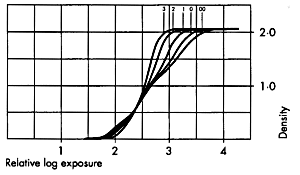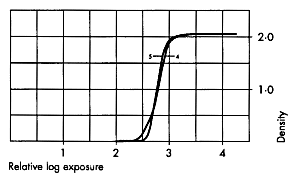PREMIUM QUALITY VARIABLE CONTRAST PAPER ON A FIBRE
BASE
ILFORD MULTIGRADE IV FB Fiber is a premium quality variable contrast
paper on a fibre base. Compared with MULTIGRADE FB, it has been improved
to give better tonal rendition throughout the contrast range, especially
in the highlights. It also has a slightly heavier weight base at 255g/m2.
MULTIGRADE IV FB Fiber is part of the ILFORD MULTIGRADE system and is fully
compatible with all existing MULTIGRADE filters and equipment. It is equally
suitable for printing from conventional . negatives and from XP2 negatives.
MULTIGRADE IV FB Fiber is available in'double weight (1 K) glossy surface
and (5K) matt surface.
EXPOSURE
MULTIGRADE IV FB Fiber is designed for use with all enlargers.
Safelight recommendations
MULTIGRADE IV FB Fiber can be used with most common safelights for
black and white papers. The ILFORD safelights are especially recommended,
however, as they generally allow dorkrooms to be brighter, but completely
safe, for MULTIGRADE IV FB Fiber and many black and white papers. ILFORD
safelights are the ILFORD SL1 darkroom safelight or the ILFORD 902 (light
brown) safelight filter fitted in o darkroom lamp (for example, the ILFORD
DLlO or DL2O). A 15W bulb is recommended with these safelights.
For direct lighting, do not expose the paper to the safelight for more
than 4 minutes, and the distance between the paper and the safelight should
be a minimum of 1 metre.
Other safelight filters can be used, for example, the Kodak OC and
the Agfa-Gevaert G7, or the Philips PF710 safelamp.
Spectral sensitivity
MULTIGRADE IV FB Fiber was tested unfiltered to produce the following
curves at density 0.5, 1 .0 and 1 .5.

Contrast range
Seven full grades of contrast, in half grade steps, are available on
MULTIGRADE IV FB Fiber paper when used with the ILFORD MULTIGRADE speed-matched
filters.
The chart gives the ISO range figures (ISO standard 6846 - 1 983) for
MULTIGRADE IV FB Fiber. These figures give a guide to selecting the appropriate
grade of paper for a given effective negative density range.
MULTIGRADE IV FB Fiber unfiltered has an ISO range of R100.
IS0 range
MULTIGRADE IV FB Fiber paper and
MULTIGRADE filters |
Filter
Range (R) |
00
170 |
0
150 |
1
130 |
2
100 |
3
80 |
4
60 |
5
40 |
The above values are representative of those obtained when dish processing
the paper to ILFORD recommendations.
ISO range figures may be helpful to printers who have some means of
measuring the effective density range of the image as projected on the
enlarger baseboard - such as with a photometer.
As an example, for a negative with an effective density range of 1
.32 log exposure units, multiply this figure by 100 and choose the nearest
ISO range figure from the table - in this case 1 30. Try printing this
negative with MULTIGRADE filter 1 on MULTIGRADE IV FB Fiber paper.
IS0 speed
The speed of MULTIGRADE IV FB Fiber depends on the filtration used
during exposure. MULTIGRADE IV FB Fiber unfiltered, has a paper speed of
ISO P500.
IS0 paper speed
MULTIGRADE IV FB Fiber paper and
MULTIGRADE filters |
Filter
Speed (P) |
00
200 |
0
-------------- |
1
-------------- |
2
-------------- |
3
200 |
4
100 |
5
100 |
The above values are representative of those obtained when dish processing
the paper to ILFORD recommendations.
Exposing light sources
MULTIGRADE IV FB Fiber is designed for use with most enlargers and
printers, that is, those fitted with either a tungsten or tungsten halogen
light source. It is also suitable for use with cold cathode (cold light)
light sources designed for variable contrast papers - further details are
given in the fact sheet 'Contrast control'. Other cold cathode (cold light)
and pulsed xenon light sources may give a reduced contrast range.
Contrast control
Contrast is controlled by using MULTIGRADE hand filters, MULTIGRADE
500 equipment, other variable contrast enlarger heads or colour enlarger
heads. Full details on contrast control with MULTIGRADE papers are given
in the fact sheet 'Contrast control'.
The twelve MULTIGRADE filters are numbered 00-5 in 1/2 steps, with
the lowest filter number corresponding to the softest contrast. The exposure
time for filters 00-31/2 is the same; that for filters 4-5 is double.
The very sophisticated ILFORD MULTIGRADE 500 exposing system replaces
the standard lamphouse on most professional enlargers.
Characteristic curves
 |
 |
MULTIGRADE IV FB Fiber glossy paper exposed through filters
00, 0, 1 , 2, 3, 4 and 5. Developer: MULTIGRADE diluted 1+9. Development:
2 minutes at 20C
PROCESSING
MULTIGRADE IV FB Fiber is processed in the same way as other fibre
base papers. Full details on processing fibre base papers are given in
the fact sheet 'Processing B&W paper - FB papers'.
Note Photographic chemicals are not hazardous when used correctly.
Always follow the health and safety recommendations on the packaging. Photochemicals
material safety data sheets containing full details for the safe handling,
disposal and tronsportation of ILFORD chemicals are available from ILFORD.
Processing summary (intermittent agitation)
ILFORD
chemical |
Dilution
|
C
|
Time
(min) |
Development
MULTIGRADE developer
or
MULTIGRADE developer |
1+9
1+14 |
20
20 |
1 1/2-3
2-5 |
Stop bath
IN-1 |
1+39 |
18-24 |
5-lOsec |
Fixation
ILFORD PAPER FIXER |
1+3 |
18-24 |
1 |
Washing
Fresh, running water |
- |
Above 5 |
60 |
Development
See the'Processing summary' for development recommendations.
On correctly exposed prints with MULTIGRADE developer 1+9, the image
will begin to appear affer 35 seconds. Development can be extended up to
6 minutes without any noticeable change in contrast or fog.
To give greater control during development, and for economy, the 1
+14 dilution of MULTIGRADE developer can be used.
MULTIGRADE IV FB Fiber paper can also be processed in other high quality
dish developers such as ILFORD PQ UNIVERSAL.
Stop Bath
See the 'Processing summary' for stop bath recommendations.
A stop bath stops development immediately, reduces the risk of staining
and will extend the life of the fixer bath.
A water rinse can be used instead of a stop bath, but it must
be changed frequently to avoid processing marks.
Fixation
See the 'Processing summary' for fixing recommendations.
The use of a hardening fixer is not recommended as it reduces washing
efficiency. ILFORD PAPER FIXER is a non-hardening fixer.
There is no benefit in extending fixation beyond the recommended time;
some loss of print quality might be seen when long fixing times are given
due to image etching.
Washing
See the 'Processing summary' for washing recommendations.
Drying
A final rinse in ILFORD ILFOTOL, diluted 1+200 with water, will
aid even and rapid drying. After washing, squeegee prints on both sides
to remove surplus water. Prints can then be air-dried at room temperature
or heat-dried.
OPTIMUM PERMANENCE
The standard fixing and washing recommendations will give excellent
print permanence for all commercial needs. When optimum permanence is needed,
perhaps for archival storage of prints, the following fixing and washing
sequences at 1 8-24C (including wash water) are recommended usin ILFORD
GALERIE WASHAID. Do not add a har ener to the fixer. Be careful not to
exceed the capacity of the fixer and not to extend the f'ixing time as
both these make washing more difficult.
0ptimum permanence sequence
Fixation
|
ILFORD PAPER FIXER
intermittent agitation |
[1+3)
|
lmin
|
| First wash |
Fresh, running water |
|
5min |
Washing aid
|
GALERIE WASHAID
intermittent agitation |
(1+4)
|
lOmin
|
| Final wash |
Fresh, running water |
|
5min |
Optimum permanence sepuence with selenium toner
Fixing
|
ILFORD PAPER FIXER
intermittent agitation, |
(1+3)
|
1 min
|
Toning
|
Selenium toner diluted with
working strength GALERIE
WASHAID instead of water,
intermittent agitation |
|
* min
|
Rinse
|
GALERIE WASHAID
intermittent agitotion |
(1+4),
|
10 min
|
| Final wash |
Fresh, running water |
|
30 min |
* Tone the print for the appropriate time to achieve the depth of colour
needed
FINISHING
MULTIGRADE IV FB Fiber responds in the same way as other fibre base
papers to the usual techniques of toning, chemical reduction and retouching.
It can be mounted using the standard techniques for fibre base papers.
Furfher detoils on finishing fibre base papers are given in the fact sheet'Processing
B&W paper- FB papers'.
STORAGE
Unprocessed paper
Store unused MULTIGRADE IV FB Fiber paper in a cool, dry place in its
original packaging. Avoid conditions of high temperature and/or high humidity.
MULTIGRADE IV FB Fiber will keep in excellent condition for up to 2 years
when stored as recommended.
Prints
MULTIGRADE IV FB Fiber prints which have been processed as recommended
in this leaflet will have a more than adequate storage life for most purposes.
Print life will be shorfened, however, in adverse storage conditions, or
if the print is exposed to oxidising gases.
It is recommended that prints made for display are toned to protect
them from the oxidising gases that are found in many environments. Selenium
toner is recommended as it has little effect on the image colour of MULTIGRADE
IV FB Fiber, but other protection methods can be used including sulphide
toning, silver image stabilisers and laminating. Full details on protecting
prints made for disploy are given in the fact sheet'Processing B&W
paper FB papers'





